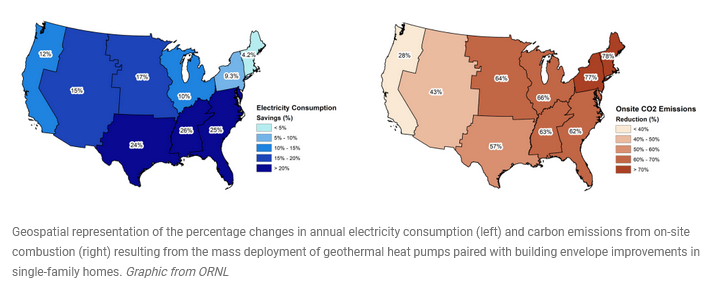By Kelly MacGregor | Contact media relations
A new analysis from Oak Ridge National Laboratory (ORNL) and the National Renewable Energy Laboratory (NREL) found that, coupled with building envelope improvements, installing geothermal heat pumps in around 70% of U.S. buildings could save as much as 593 terawatt-hours of electricity generation annually and avoid seven gigatons of carbon-equivalent emissions by 2050.

"To put that in context, 593 terawatt-hours is about 15% of the current annual electricity demand in the United States," said Jonathan Ho, lead NREL researcher for the analysis.
Widespread geothermal heat pump installations could also save 24,500 miles of new grid transmission lines from needing to be built (36.7 TW-mi) the equivalent of crossing the United States eight times because of a reduced need for generation capacity, storage, and transmission compared to other energy pathways.
This means geothermal heat pumps could provide benefits to all electricity consumers, even those who cannot install geothermal heat pumps themselves.
"Geothermal heat pumps also called ground-source heat pumps, or geo-exchange use the relatively constant temperature of Earth's subsurface to heat and cool, which is highly efficient," said Amanda Kolker, NREL geothermal laboratory program manager. "Widespread adoption of this resilient and mature technology could enable us to decarbonize the building sector with minimal increases in electricity demand. They can be installed at multiple scales, decarbonizing individual buildings or networks of buildings."
Funded by the U.S. Department of Energy's Geothermal Technologies Office, the analysis also includes preliminary results that suggest switching to geothermal heat pumps could reduce the challenges of maintaining electricity supply during high-use periods. And combining geothermal heat pumps with additional efficiency measures, such as building weatherization, can further increase benefits for energy users and the electricity grid while bolstering a domestic industry.
"Most geothermal heat pump equipment for the U.S. market is made locally, and additional local jobs would be created to install and maintain the systems," Ho said.
Geothermal heat pumps can be used to heat and cool individual homes or businesses as well as networks of buildings such as college campuses, downtown districts, or housing developments. They can be used in all climates and in both urban and rural environments. They can also be installed during new construction or added during renovations to existing buildings, and tens of thousands are already in use across the country.
"Geothermal heat pumps offer enormous value for the nation's energy future," said Alejandro Moreno, U.S. Department of Energy associate principal deputy assistant secretary for energy efficiency and renewable energy. "This report confirms that geothermal heat pumps are a ready-made strategy for decarbonizing our buildings while reducing the need for new electricity generation and transmission and bringing energy savings to Americans nationwide all while creating U.S. jobs."
Discover more information on NREL geothermal research.









